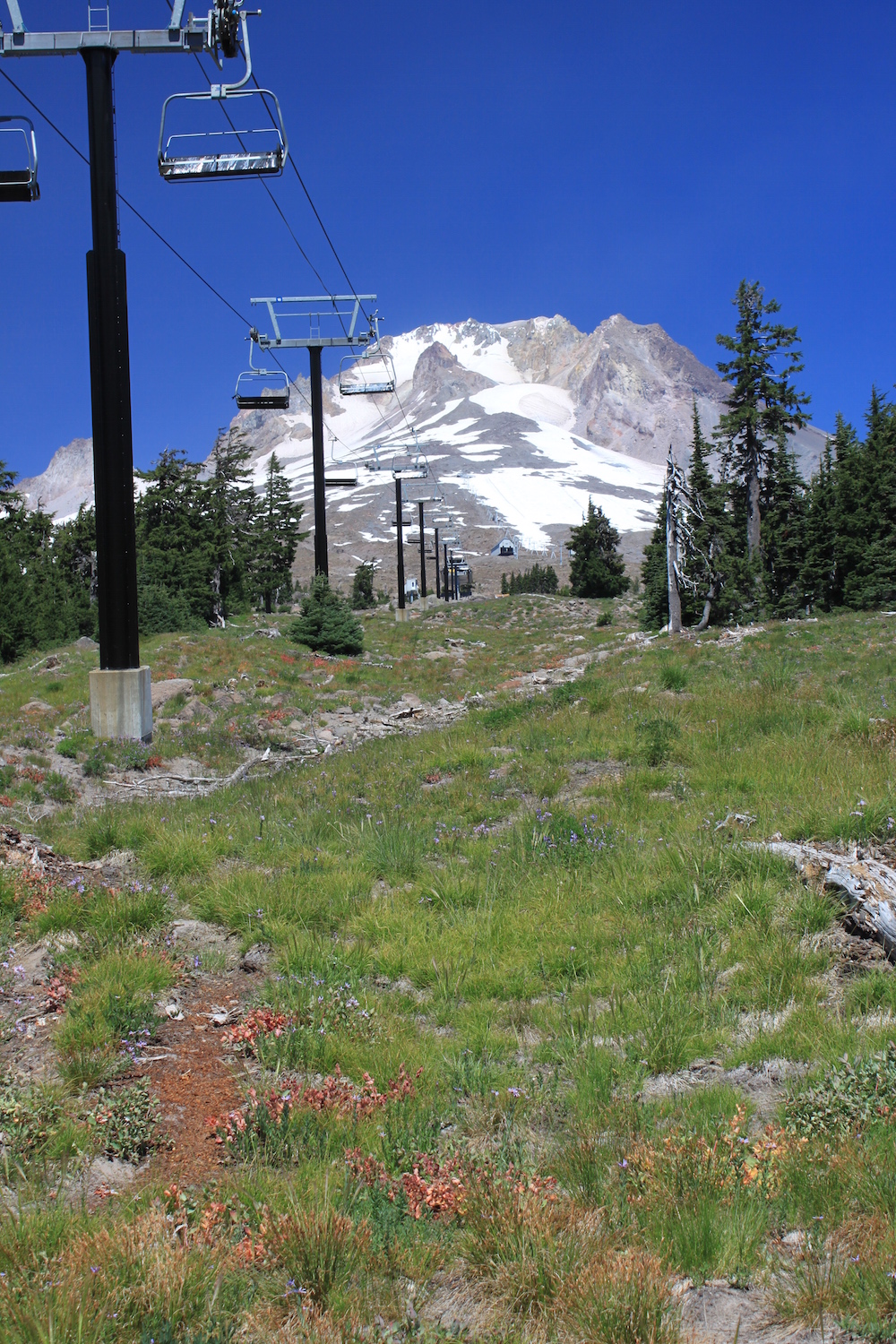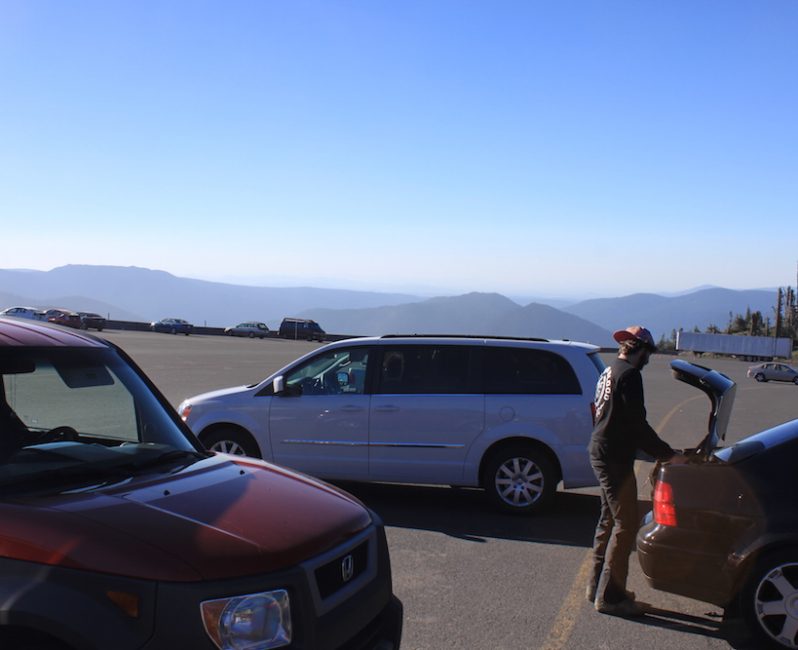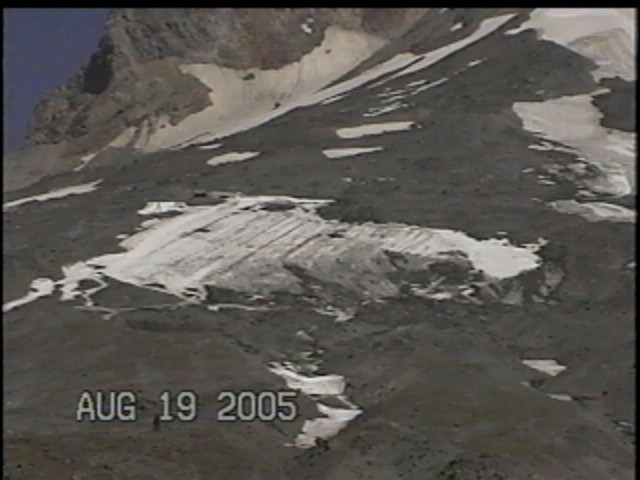Stuck in a lazy mid-August rut with an extreme heat warning for Western Oregon forecasting too much torpor for my well-being, I decided to dig out the boards and gain some altitude for my first-ever August ski session on Mount Hood.
It was one of the better decisions I’ve made recently, which isn’t saying much, but still. The closer I got to the mountain, the better I felt. The wind was howling fresh from the east when I arrived in the Timberline parking lot, visibility was incredible, and there was pretty much nobody there—at least at 8 am.
I checked in with my buddy Miles from Timberline guest services and he told me it has been a good summer up on Hood, especially after last season’s low-snow struggles. The numbers were down, but the snow had held up and was still holding up despite the heat. Windells and High Cascade got all their sessions in, and Mt. Hood Summer Ski & Snowboard Camp was planning to continue into September. In other words, back to normal for the ski resort with the longest snow season in North America.
Riding up the Magic Mile lift with my skis on my lap, I got a good view of what the Mile and Palmer look like when not blanketed with snow:
Before long I was up at 8500 feet, and the east wind that had been ripping at lower elevations was gone. It was quiet and peaceful, with maybe 50 skiers and snowboarders total on the snow: a few racing teams, a dozen top-notch Canadian mogul skiers and a handful of snowboarders and freeskiers waiting for the snow to soften up in the public park. Plus some incredibly talented paralympic skiers like Kurt Oadway, carving beautiful turns at 30 or 40 miles an hour.
I met up with Robin Cressy from Mt. Hood Summer Ski & Snowboard Camp, and he filled me in on how things have been going this summer. Robin has been a Palmer Snowfield regular for a long time, and he and MHSSC stuck it out to the bitter end last summer season, walking down 50 yards over rocks from the top of Palmer each run to get the summer snow campers their money’s worth. The camps coaxed Timberline into staying open until August 12 last summer, but it took a lot of ingenuity to make that work. This summer the snowpack is deep enough to hold up to the meanest of heat waves. MHSCC signed up over 600 campers for 2016, and they plan to run sessions straight through to September 3.
With just 50 people spread out over the snow, you might things would be a bit slow. Far from it. It’s a lively group of people who are happy to be where they are: a vacationing pilot working on his racing turns, some teenage girls smoothing out their style in the bumps, and free spirits like Rick Millett, who coaches the snowboarders with MHSSC.
“What are you up to this weekend, Rick?” Robin asks his colleague.
“I’m just hoping my boss pays me so I can do some responsible things – like register new snowmobile, pay my Verizon bill. You know, stuff normal people do.”
Millett stomps on some snow and addresses the young riders training with him:
“Let’s go get that jump bros – let’s do it!”
A few minutes later,
There’s not a lot of snow in the background of that photo, but I find out as I head out to make a few laps and take a few shots that the snow underfoot is surprisingly good. There are GS courses set up in the lanes, a mogul field with a large jump and a public park with jumps, rails and a solid halfpipe. It just takes a few turns and a bit of speed to get the blood flowing.
Last year’s low-snow summer on Mount Hood was disconcerting to say the least, especially when combined with droughts and wildfires in California, floods in Louisiana and the steady melting of the Greenland Ice Sheet. Can the Palmer Snowfield survive?
Mike Annett, who started MHSSC in 1978, has confidence that the natural snow-collecting features of Palmer will provide a decent snowpack on Mt. Hood well into the future. The gulleys and gulches of Palmer collect snow all winter as the westerly winds blow it across the mountain, and by summer the snowpack is often 20 feet deep or more. MHSSC moguls coach Darren Owen.
“I think this glacier is going to last forever,” says Owen. “It’s gonna survive.”
It is pretty amazing to be up skiing on one of the hottest days of a hot summer, but by noon things start getting messy, and no amount of ice is going to make that sticky snow fun to shred. So I headed on down to the lodge and switched from skiing to hiking gear, and before long I was out on the Pacific Crest Trail with a steady flow of hard-core troubadours from all over the world marching through the Oregon Cascades. I sat down in the shade with a hiker named Andrew who was well on his way from Mexico to Canada, never mind a serious knee injury that necessitated some last-minute, uninsured health care. $5500 out-of-pocket later, he got right back on the trail, pounding out 28, 34, 32 miles per day, feet taking a beating but he says he’s never felt stronger or happier.
“Bridge of the Gods, here I come,” Andrew announced as he loped his way back to the dusty trail.
“You are going to enjoy this stretch of trail,” I predicted, and as he walked off on his way my mind flashed with memories and images from 20 years of exploring the Cascades. Stevens Pass, Timberline, Blanca Lake, Alpental and the Alpine Lakes, Heather Canyon, Illumination Rock, and many, many beautiful places in between.

{igallery id=6514|cid=79|pid=2|type=category|children=0|addlinks=0|tags=|limit=0}
Last modified: August 19, 2016



